WE’VE RELEASED A NEW BOOK: A PLACE TO CALL HOME
Call it affordable housing, Gen-Z rentals or luxury apartments, a sense of home and community must lie at the heart of every Build To Rent (BTR) offering.
The recent growth in Australia’s nascent BTR sector is staggering. ARM has been a pioneer in the BTR market for 6 years, and we continue to remain at the forefront of a sector we believe has the potential to change the face of Australia’s property market.
Our strong research ethos and innovative design approach have seen us design Australia’s two biggest existing BTR projects in Smith Collective (Gold Coast) and Realm Caulfield, (Melbourne). Guiding developers through the BTR journey through our collective industry expertise continues to be a significant facet of our architectural practice.

A combination of factors have influenced the recent BTR boom in Australia, including increased housing affordability, changing home-buyer demographics, employment centres out of the CBD, and, naturally, the social and financial impact of the pandemic on potential home-buyers. Put simply, the industry can’t catch up with the current rental demand across Australia given the idea that home ownership is no longer an option for many people.
As a result of this, we perceive immense opportunity to further establish our work in Australia’s BTR market and we are placing ourselves in the best position to attract a large portion of our work from BTR clients.
ARM embraces the opportunity to work with Australian developers in designing and delivering world-class BTR offerings reflecting a sense of place and purpose. What excites us most about this prospect is the immense potential we see to craft a more sustainable and considered BTR offering in an Australian context.

ARM’s take on BTR in a snapshot…
- A sense of community is a key differentiator between BTS and BTR assets.
- Design for the selling point: amenity, amenity, amenity.
- The tenant becomes the customer in a BTR context, meaning they are empowered to ‘shop around’ for an offering that best suits their lifestyle, both now and in the future.
- BTR owners must cultivate a long-term relationship with their customer, the tenant, via innovative design outcomes promoting a sense of belonging on a personal and collective level.
- Quality design outcomes can elevate common perceptions of BTR assets, including the idea that they are only suitable for low to middle-income earners, they aren’t designed to be long-term accommodation, and that they are only appealing to millennials.

As an early adopter of the BTR model in Australia, we have proven our expertise in executing designs of quality and longevity.
Our vision has been brought to life in buildings, campuses, and entire precincts that continue to serve communities across the country. We are proud to be regarded as the trusted and preferred architectural practice for BTR projects in Australia, currently undertaking two new BTR developments in inner city and prime suburban settings.
Although we talk about BTR as a new model in Australia, it is in fact return to the old landlord model. Relatively small developers are delivering apartments and residential communities they own wholly and generate revenue through. We’re simply talking about institutionalising this model.
The community housing sector has played the role of institutional landlord for over 30 years in Australia. The offering for secure, long-term accommodation offered by BTR assets means this offering is now available to the entire breadth of the market.
This publication seeks to further impart ARM’s BTR sector and project knowledge amassed by our team over the years, with reference to our key learnings from BTR projects that are held as industry exemplars of how rigorous research and considered design outcomes can turn a BTR asset into a place to call home for millions of people across Australia.